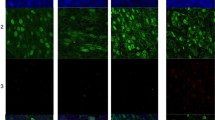Abstract
Platinum-based chemoradiotherapy (CRT) is a preferred standard of care for locally advanced head and neck cancer (HNC). However, survival benefit is small, with substantial toxicity and biomarkers of CRT resistance that could guide treatment selection and spare morbidity. Increased DNA repair in solid tumors may contribute to cancer cells’ ability to survive in genotoxic stress environments afforded by therapy. We assessed mRNA expression levels of DNA repair-related genes BRCA1, RAP80, 53 binding protein 1 (53BP1), mediator of DNA damage checkpoint 1 (MDC1), and RNF8. We correlated our findings with response and overall survival in 72 head and neck patients treated with weekly carboplatin AUC 2 and radiotherapy. Complete response (CR) to CRT was 50 % in patients with low levels of 53BP1 compared to 6.3 % in patients with high levels (p = 0.0059). Of high BRCA1 mRNA expressors, 41.2 % had CR compared to 29.4 % of low expressors (p = 0.72). For a small group of patients with low 53BP1 and either high BRCA1 or RAP80, CRs were 66.7 and 71.4 %, respectively. A trend for better overall survival (OS) was found for patients with low 53BP1 (15 vs 8 m; p = 0.056). Our findings highlight the potential usefulness of 53BP1 mRNA as a predictive biomarker of response and overall survival in HNC patients treated with chemoradiotherapy. Those with high 53BP1 expression could derive only a meager benefit from treatment. Analysis of BRCA1 and RAP80 could further reinforce the predictive value of 53BP1. Although this was a retrospective study with small sample size, it could inform larger translational studies in HNC.



Similar content being viewed by others
References
Pignon J-P, Bourhis J. On behalf of the MACH-NC Collaborative Group. Chemotherapy added to locoregional treatment for head and neck squamous-cell carcinoma: three meta-analyses of updated individual data. Lancet. 2000;255:949–55.
Pignon J-P, le Maître A. Meta-analysis of chemotherapy in head and neck cancer (MaCH-NC): an update on 93 randomised trials and 17,346 patients. Radiother Oncol. 2009;92:4–14.
Machtay M, Moughan J. Factors associated with severe late toxicity after concurrent chemoradiation for locally advanced head and neck cancer: an RTOG analysis. J Clin Oncol. 2008;26(21):3582–9.
Forastiere A, Goepfert H. Concurrent chemotherapy and radiotherapy for organ preservation in advanced laryngeal cancer. N Engl J Med. 2003;349:2091–8.
Wei M, Zou Z. Customized chemotherapy in metastatic non-small cell lung cancer. Transl Lung Cancer Res. 2013;2(3):180–8.
Lieber MR. The mechanism of double-strand DNA break repair by the non-homologous DNA end-joining pathway. Annu Rev Biochem. 2010;79:181–211.
San Filippo J, Sung P. Mechanism of eukaryotic homologous recombination. Annu Rev Biochem. 2008;77:229–57.
Dever S, White ER. BRCA1-directed, enhanced and aberrant homologous recombination. Cell Cycle. 2012;11(4):687–94.
Noon AT, Goodarzi AA. 53BP1-mediated DNA double strand break repair: insert bad pun here. DNA Repair (Amst). 2011;10(10):1071–6.
Bothmer A, Robbiani DF. Regulation of DNA end joining, resection, and immunoglobulin class switch recombination by 53BP1. Mol Cell. 2011;42(3):319–29.
Pei H, Zhang L. MMSET regulates histone H4K20 methylation and 53BP1 accumulation at DNA damage sites. Nature. 2011;470(7332):124–8.
Hudlebusch HR, Santoni-Rugiu E. The histone methyltransferase and putative oncoprotein MMSET is over expressed in a large variety of human tumors. Clin Cancer Res. 2011;17(9):2919–33.
Taron M, Rosell R. BRCA1 mRNA expression levels as an indicator of chemoresistance in lung cancer. Hum Mol Genet. 2004;13(20):2443–9.
Quinn JE, James CR. BRCA1 mRNA expression levels predict for overall survival in ovarian cancer after chemotherapy. Clin Cancer Res. 2007;13(24):7413–20.
Font A, Taron M. BRCA1 mRNA expression and outcome to neoadjuvant cisplatin-based chemotherapy in bladder cancer. Ann Oncol. 2011;22(1):139–44.
Margeli M, Cirauqui B. The prognostic value of BRCA1 mRNA expression levels following neoadjuvant chemotherapy in breast cancer. PLoS One. 2010;5(3):e9499.
Wei J, Costa C. mRNA expression of BRCA1, PIAS1, and PIAS4 and survival after second-line docetaxel in advanced gastric cancer. J Natl Cancer Inst. 2011;103(20):1552–6.
Rosell R, Perez-Roca L. Customized treatment in non-small-cell lung cancer based on EGFR mutations and BRCA1 mRNA expression. PLoS One. 2009;4(5):e5133.
Moran T, Wei J. Two biomarker-directed randomized trials in European and Chinese patients with nonsmall-cell lung cancer: the BRCA1-RAP80 Expression Customization (BREC) studies. Ann Oncol. 2014;25:2147–55.
Bonanno L, Costa C. The predictive value of 53BP1 and BRCA1 mRNA expression in advanced non-small-cell lung cancer patients treated with first-line platinum-based chemotherapy. Oncotarget. 2013;4(10):1572–81.
Boeckman HJ, Trego KS. Cisplatin sensitizes cancer cells to ionizing radiation via inhibition of nonhomologous end joining. Mol Cancer Res. 2005;3(5):277–85.
The Cancer Genome Atlas Network. Comprehensive genomic characterization of head and neck squamous cell carcinomas. Nature. 2015;517:576–82.
Allen C, Halbrook J. Interactive competition between homologous recombination and non-homologous end joining. Mol Cancer Res. 2003;1:913–20.
Panier S, Boulton SJ. Double-strand break repair: 53BP1 comes into focus. Nat Rev Mol Cell Biol. 2014;15:7–18.
Mukherjee B, Choy H. Targeting non-homologous end-joining through epidermal growth factor receptor inhibition: rationale and strategies for radiosensitization. Semin Radiat Oncol. 2010;20(4):250–7.
Ang KK. Impact of epidermal growth factor receptor expression on survival and pattern of relapse in patients with advanced head and neck carcinoma. Cancer Res. 2002;62(24):7350–6.
Nyati MK. Integration of EGFR inhibitors with radiochemotherapy. Nat Rev Cancer. 2006;6(11):876–85.
Author information
Authors and Affiliations
Corresponding author
Additional information
This work was conducted under the doctorate in medicine from the Autonomous University of Barcelona.
Rights and permissions
About this article
Cite this article
Cirauqui, B., Margelí, M., Quiroga, V. et al. DNA repair pathways to regulate response to chemoradiotherapy in patients with locally advanced head and neck cancer. Tumor Biol. 37, 13435–13443 (2016). https://doi.org/10.1007/s13277-016-5149-0
Received:
Accepted:
Published:
Issue Date:
DOI: https://doi.org/10.1007/s13277-016-5149-0




